Anesthetics and Cell–Cell Communication: Potential Ca2+-Calmodulin Role in Gap Junction Channel Gating by Heptanol, Halothane and Isoflurane
Abstract
:1. Introduction
2. Measurement of Junctional Resistance (Rj), [Ca2+]i and [H+]i in Crayfish Septate Axons
3. Gating by Heptanol in the Presence and Absence of Caffeine or Theophylline
4. Gating by Halothane or Isoflurane in the Presence and Absence of Caffeine
5. Potential Mechanism of Channel Gating by Anesthetics
5.1. Does Uncoupling by Anesthetics Result from Increased [Ca2+]i Potentiated by Caffeine and Theophylline?
5.2. Role of a Potential Soluble Intermediate—Calmodulin
6. Summary and Conclusions
- Halothane binds to CaM [78].
- Anesthetics cause Ca2+ release via both IP3- and RyR-receptor channels [38].
- Lack of cyclic nucleotide role, excluded by experiments with IBMX (a phosphodiesterase inhibitor), forskolin (an activator of adenylate cyclase) or diffusible cAMP and cGMP.
- Absence of kinase C role, tested with TPA (activator) or H7 (inhibitor).
- Lack of adenosine-receptor role, tested with adenosine and IBMX treatments.
- Evidence that the peak of depolarization caused by anesthetics or anesthetics–caffeine matches the peak of Rj rise.
- Ryanodine-induced inhibition of Rj rise with heptanol–caffeine.
- There is evidence that the second exposure to heptanol or heptanol–caffeine has a much smaller effect on Rj, suggesting partial depletion of Ca2+ stores by the previous exposure.
Funding
Conflicts of Interest
References
- Peracchia, C. Gap Junction Stucture and Chemical Regulation. Direct Calmodulin Role in Cell-to-Cell Channel Gating; An Imprint of Elsevier; Academic Press: London, UK, 2019. [Google Scholar]
- Délèze, J. Calcium ions and the healing over of heart fibers. In Electrophysiology of the Heart; Taccardi, B., Marchetti, C., Eds.; Pergamon Press: Oxford, UK, 1965; pp. 147–148. [Google Scholar]
- Kanno, Y.; Loewenstein, W.R. Low-resistance coupling between gland cells. Some observations on intercellular contact membranes and intercellular space. Nature 1964, 201, 194–195. [Google Scholar] [CrossRef]
- Rose, B.; Loewenstein, W.R. Permeability of a cell junction and the local cytoplasmic free ionized calcium concentration: A study with aequorin. J. Membr. Biol. 1976, 28, 87–119. [Google Scholar] [CrossRef]
- Noma, A.; Tsuboi, N. Direct measurement of the gap junctional conductance under the influence of Ca2+ in dissociated paired myocytes of guinea-pig. Jpn. Heart J. 1986, 27 (Suppl. S1), 161–166. [Google Scholar] [PubMed]
- Lazrak, A.; Peracchia, C. Gap junction gating sensitivity to physiological internal calcium regardless of pH in Novikoff hepatoma cells. Biophys. J. 1993, 65, 2002–2012. [Google Scholar] [CrossRef]
- Peracchia, C. Chemical gating of gap junction channels; roles of calcium, pH and calmodulin. Biochim. Biophys. Acta 2004, 1662, 61–80. [Google Scholar] [CrossRef] [PubMed]
- Peracchia, C.; Bernardini, G.; Peracchia, L.L. Is calmodulin involved in the regulation of gap junction permeability? Pflügers Arch. 1983, 399, 152–154. [Google Scholar] [CrossRef] [PubMed]
- Peracchia, C. Communicating junctions and calmodulin: Inhibition of electrical uncoupling in Xenopus embryo by calmidazolium. J. Membr. Biol. 1984, 81, 49–58. [Google Scholar] [CrossRef] [PubMed]
- Peracchia, C. Calmodulin-like proteins and communicating junctions. Electrical uncoupling of crayfish septate axons is inhibited by the calmodulin inhibitor W7 and is not affected by cyclic nucleotides. Pflügers Arch. 1987, 408, 379–385. [Google Scholar] [CrossRef]
- Peracchia, C. Calmodulin-mediated regulation of gap junction channels. Int. J. Mol. Sci. 2020, 21, 485. [Google Scholar] [CrossRef] [PubMed]
- Peracchia, C.; Leverone Peracchia, L.M. Calmodulin-connexin partnership in gap junction channel regulation - Calmodulin-cork gating model. Int. J. Mol. Sci. 2021, 22, 13055. [Google Scholar] [CrossRef] [PubMed]
- Zou, J.; Salarian, M.; Chen, Y.; Veenstra, R.; Louis, C.F.; Yang, J.J. Gap junction regulation by calmodulin. FEBS Lett. 2014, 588, 1430–1438. [Google Scholar] [CrossRef]
- Johnston, M.F.; Simon, S.A.; Ramon, F. Interaction of anaesthetics with electrical synapses. Nature 1980, 286, 498–500. [Google Scholar] [CrossRef] [PubMed]
- Bastide, B.; Herve, J.C.; Cronier, L.; Délèze, J. Rapid onset and calcium independence of the gap junction uncoupling induced by heptanol in cultured heart cells. Pflügers Arch. 1995, 429, 386–393. [Google Scholar] [CrossRef]
- Peracchia, C. Effects of the anesthetics heptanol, halothane and isoflurane on gap junction conductance in crayfish septate axons: A calcium- and hydrogen-independent phenomenon potentiated by caffeine and theophylline, and inhibited by 4-aminopyridine. J. Membr. Biol. 1991, 121, 67–78. [Google Scholar] [CrossRef] [PubMed]
- Eskandari, S.; Zampighi, G.A.; Leung, D.W.; Wright, E.M.; Loo, D.D. Inhibition of gap junction hemichannels by chloride channel blockers. J. Membr. Biol. 2002, 185, 93–102. [Google Scholar] [CrossRef] [PubMed]
- Hagan, C.E.; Pearce, R.A.; Trudell, J.R.; MacIver, M.B. Concentration measures of volatile anesthetics in the aqueous phase using calcium sensitive electrodes. J. Neurosci. Methods 1998, 81, 177–184. [Google Scholar] [CrossRef]
- Johnston, M.F.; Ramon, F. Electrotonic coupling in internally perfused crayfish segmented axons. J. Physiol. 1981, 317, 509–518. [Google Scholar] [CrossRef]
- Peracchia, C. Effects of caffeine and ryanodine on low pHi-induced changes in gap junction conductance and calcium concentration in crayfish septate axons. J. Membr. Biol. 1990, 117, 79–89. [Google Scholar] [CrossRef] [PubMed]
- Peracchia, C. Increase in gap junction resistance with acidification in crayfish septate axons is closely related to changes in intracellular calcium but not hydrogen ion concentration. J. Membr. Biol 1990, 113, 75–92. [Google Scholar] [CrossRef] [PubMed]
- Kramer, G.L.; Wells, J.N. Xanthines and skeletal muscle: Lack of relationship between phosphodiesterase inhibition and increased twitch tension in rat diaphragms. Mol. Pharmacol. 1980, 17, 73–78. [Google Scholar] [PubMed]
- Marone, G.; Plaut, M.; Lichtenstein, L.M. Characterization of a specific adenosine receptor on human lymphocytes. J. Immunol. 1978, 121, 2153–2159. [Google Scholar]
- Schwabe, U.; Ukena, D.; Lohse, M.J. Xanthine derivatives as antagonists at A1 and A2 adenosine receptors. Naunyn Schmiedebergs Arch. Pharmacol. 1985, 330, 212–221. [Google Scholar] [CrossRef]
- Meda, P.; Bruzzone, R.; Knodel, S.; Orci, L. Blockage of cell-to-cell communication within pancreatic acini is associated with increased basal release of amylase. J. Cell Biol. 1986, 103, 475–483. [Google Scholar] [CrossRef]
- Sjodin, L.; Dahlen, H.G.; Lund, P.E.; Gylfe, E. Stimulation of pancreatic amylase release is associated with a parallel sustained increase of cytoplasmic calcium. Regul. Pept. 1990, 30, 239–253. [Google Scholar] [CrossRef]
- Pandol, S.J.; Schoeffield, M.S.; Sachs, G.; Muallem, S. Role of free cytosolic calcium in secretagogue-stimulated amylase release from dispersed acini from guinea pig pancreas. J. Biol. Chem. 1985, 260, 10081–10086. [Google Scholar] [CrossRef]
- Kanno, T. Calcium-dependent amylase release and electrophysiological measurements in cells of the pancreas. J. Physiol. 1972, 226, 353–371. [Google Scholar] [CrossRef]
- Somogyi, R.; Kolb, H.A. Cell-to-cell channel conductance during loss of gap junctional coupling in pairs of pancreatic acinar and Chinese hamster ovary cells. Pflügers Arch. 1988, 412, 54–65. [Google Scholar] [CrossRef]
- Burt, J.M.; Spray, D.C. Single-channel events and gating behavior of the cardiac gap junction channel. Proc. Natl. Acad. Sci. USA 1988, 85, 3431–3434. [Google Scholar] [CrossRef]
- Niggli, E.; Rudisuli, A.; Maurer, P.; Weingart, R. Effects of general anesthetics on current flow across membranes in guinea pig myocytes. Am. J. Physiol. 1989, 256 Pt 1, C273–C281. [Google Scholar] [CrossRef]
- Rudisuli, A.; Weingart, R. Electrical properties of gap junction channels in guinea-pig ventricular cell pairs revealed by exposure to heptanol. Pflügers Arch. 1989, 415, 12–21. [Google Scholar] [CrossRef]
- Veenstra, R.D.; Dehaan, R.L. Cardiac gap junction channel activity in embryonic chick ventricle cells. Am. J. Physiol. 1988, 254 Pt 2, H170–H180. [Google Scholar] [CrossRef]
- Vassort, G.; Whittembury, J.; Mullins, L.J. Increases in internal Ca2+ and decreases in internal H+ are induced by general anesthetics in squid axons. Biophys. J. 1986, 50, 11–19. [Google Scholar] [CrossRef]
- Daniell, L.C.; Harris, R.A. Neuronal intracellular calcium concentrations are altered by anesthetics: Relationship to membrane fluidization. J. Pharmacol. Exp. Ther. 1988, 245, 1–7. [Google Scholar]
- Requena, J.; Whittembury, J.; Tiffert, T.; Eisner, D.A.; Mullins, L.J. The influence of chemical agents on the level of ionized [Ca2+] in squid axons. J. Gen. Physiol. 1985, 85, 789–804. [Google Scholar] [CrossRef] [PubMed]
- Mullins, L.J.; Requena, J.; Whittembury, J. Ca2+ entry in squid axons during voltage-clamp pulses is mainly Na+/Ca2+ exchange. Proc. Natl. Acad. Sci. USA 1985, 82, 1847–1851. [Google Scholar] [CrossRef] [PubMed]
- Pabelick, C.M.; Prakash, Y.S.; Kannan, M.S.; Warner, D.O.; Sieck, G.C. Effects of halothane on sarcoplasmic reticulum calcium release channels in porcine airway smooth muscle cells. Anesthesiology 2001, 95, 207–215. [Google Scholar] [CrossRef] [PubMed]
- Deutsch, D.E.; Williams, J.A.; Yule, D.I. Halothane and octanol block Ca2+ oscillations in pancreatic acini by multiple mechanisms. Am. J. Physiol. 1995, 269 Pt 1, G779–G788. [Google Scholar] [CrossRef]
- Zullo, A.; Textor, M.; Elischer, P.; Mall, S.; Alt, A.; Klingler, W.; Melzer, W. Voltage modulates halothane-triggered Ca2+ release in malignant hyperthermia-susceptible muscle. J. Gen. Physiol. 2018, 150, 111–125. [Google Scholar] [CrossRef]
- Akata, T.; Boyle, W., 3rd. Dual actions of halothane on intracellular calcium stores of vascular smooth muscle. Anesthesiology 1996, 84, 580–595. [Google Scholar] [CrossRef]
- Yang, H.; Liang, G.; Hawkins, B.J.; Madesh, M.; Pierwola, A.; Wei, H. Inhalational anesthetics induce cell damage by disruption of intracellular calcium homeostasis with different potencies. Anesthesiology 2008, 109, 243–250. [Google Scholar] [CrossRef]
- Wei, H.; Inan, S. Dual effects of neuroprotection and neurotoxicity by general anesthetics: Role of intracellular calcium homeostasis. Prog. Neuropsychopharmacol. Biol. Psychiatry 2013, 47, 156–161. [Google Scholar] [CrossRef]
- Sauviat, M.P.; Frizelle, H.P.; Descorps-Declere, A.; Mazoit, J.X. Effects of halothane on the membrane potential in skeletal muscle of the frog. Br. J. Pharmacol. 2000, 130, 619–624. [Google Scholar] [CrossRef] [PubMed]
- Deleze, J.; Herve, J.C. Effect of several uncouplers of cell-to-cell communication on gap junction morphology in mammalian heart. J. Membr. Biol. 1983, 74, 203–215. [Google Scholar] [CrossRef] [PubMed]
- Deleze, J.; Herve, J.C. Quantitative gap junction alterations in mammalian heart cells quickly frozen or chemically fixed after electrical uncoupling. J. Membr. Biol. 1986, 93, 11–21. [Google Scholar] [CrossRef] [PubMed]
- Bernardini, G.; Peracchia, C.; Peracchia, L.L. Reversible effects of heptanol on gap junction structure and cell-to-cell electrical coupling. Eur. J. Cell Biol. 1984, 34, 307–312. [Google Scholar] [PubMed]
- Weinrich, M.; Nanda, H.; Worcester, D.L.; Majkrzak, C.F.; Maranville, B.B.; Bezrukov, S.M. Halothane changes the domain structure of a binary lipid membrane. Langmuir 2012, 28, 4723–4728. [Google Scholar] [CrossRef]
- Caspar, D.L.; Goodenough, D.A.; Makowski, L.; Phillips, W.C. Gap junction structures. I. Correlated electron microscopy and x-ray diffraction. J. Cell Biol. 1977, 74, 605–628. [Google Scholar] [CrossRef]
- Evans, W.H.; Gurd, J.W. Preparation and properties of nexuses and lipid-enriched vesicles from mouse liver plasma membranes. Biochem. J. 1972, 128, 691–700. [Google Scholar] [CrossRef] [PubMed]
- Henderson, D.; Eibl, H.; Weber, K. Structure and biochemistry of mouse hepatic gap junctions. J. Mol. Biol. 1979, 132, 193–218. [Google Scholar] [CrossRef]
- Hertzberg, E.L.; Gilula, N.B. Isolation and characterization of gap junctions from rat liver. J. Biol. Chem. 1979, 254, 2138–2147. [Google Scholar] [CrossRef]
- Bastiaanse, E.M.; Jongsma, H.J.; van der Laarse, A.; Takens-Kwak, B.R. Heptanol-induced decrease in cardiac gap junctional conductance is mediated by a decrease in the fluidity of membranous cholesterol-rich domains. J. Membr. Biol. 1993, 136, 135–145. [Google Scholar] [CrossRef] [PubMed]
- Sheetz, M.P.; Singer, S.J. Biological membranes as bilayer couples. A molecular mechanism of drug-erythrocyte interactions. Proc. Natl. Acad. Sci. USA 1974, 71, 4457–4461. [Google Scholar] [CrossRef]
- Lorent, J.H.; Levental, K.R.; Ganesan, L.; Rivera-Longsworth, G.; Sezgin, E.; Doktorova, M.; Lyman, E.; Levental, I. Plasma membranes are asymmetric in lipid unsaturation, packing and protein shape. Nat. Chem. Biol. 2020, 16, 644–652. [Google Scholar] [CrossRef] [PubMed]
- Nickels, T.J.; Schwartz, A.D.; Blevins, D.E.; Drummond, J.T.; Reed, G.W.; Wilson, D.F. Effect of theophylline and aminophylline on transmitter release at the mammalian neuromuscular junction is not mediated by cAMP. Clin. Exp. Pharmacol. Physiol. 2006, 33, 465–470. [Google Scholar] [CrossRef]
- Reggiani, C. Caffeine as a tool to investigate sarcoplasmic reticulum and intracellular calcium dynamics in human skeletal muscles. J. Muscle Res. Cell Motil. 2021, 42, 281–289. [Google Scholar] [CrossRef] [PubMed]
- Rosenberg, H.; Pollock, N.; Schiemann, A.; Bulger, T.; Stowell, K. Malignant hyperthermia: A review. Orphanet. J. Rare Dis. 2015, 10, 93. [Google Scholar] [CrossRef]
- Bezprozvanny, I.; Bezprozvannaya, S.; Ehrlich, B.E. Caffeine-induced inhibition of inositol(1,4,5)-trisphosphate-gated calcium channels from cerebellum. Mol. Biol. Cell 1994, 5, 97–103. [Google Scholar] [CrossRef] [PubMed]
- Parker, I.; Ivorra, I. Caffeine inhibits inositol trisphosphate-mediated liberation of intracellular calcium in Xenopus oocytes. J. Physiol. 1991, 433, 229–240. [Google Scholar] [CrossRef] [PubMed]
- Saleem, H.; Tovey, S.C.; Molinski, T.F.; Taylor, C.W. Interactions of antagonists with subtypes of inositol 1,4,5-trisphosphate (IP3) receptor. Br. J. Pharmacol. 2014, 171, 3298–3312. [Google Scholar] [CrossRef]
- Joseph, J.D.; Peng, Y.; Mak, D.O.; Cheung, K.H.; Vais, H.; Foskett, J.K.; Wei, H. General anesthetic isoflurane modulates inositol 1,4,5-trisphosphate receptor calcium channel opening. Anesthesiology 2014, 121, 528–537. [Google Scholar] [CrossRef]
- Laver, D.R.; Attia, J.; Oldmeadow, C.; Quail, A.W. Cardiac Calcium Release Channel (Ryanodine Receptor 2) Regulation by Halogenated Anesthetics. Anesthesiology 2017, 126, 495–506. [Google Scholar] [CrossRef]
- Connelly, T.J.; Coronado, R. Activation of the Ca2+ release channel of cardiac sarcoplasmic reticulum by volatile anesthetics. Anesthesiology 1994, 81, 459–469. [Google Scholar] [CrossRef]
- Komai, H.; Rusy, B.F. Effect of halothane on rested-state and potentiated-state contractions in rabbit papillary muscle: Relationship to negative inotropic action. Anesth. Analg. 1982, 61, 403–409. [Google Scholar] [CrossRef]
- He, D.S.; Burt, J.M. Mechanism and selectivity of the effects of halothane on gap junction channel function. Circ. Res. 2000, 86, E104–E109. [Google Scholar] [CrossRef]
- Xu, Q.; Kopp, R.F.; Chen, Y.; Yang, J.J.; Roe, M.W.; Veenstra, R.D. Gating of connexin 43 gap junctions by a cytoplasmic loop calmodulin binding domain. Am. J. Physiol. Cell Physiol. 2012, 302, C1548–C1556. [Google Scholar] [CrossRef]
- Dityatev, A.E.; Clamann, H.P. Reliability of spike propagation in arborizations of dorsal root fibers studied by analysis of postsynaptic potentials mediated by electrotonic coupling in the frog spinal cord. J. Neurophysiol. 1996, 76, 3451–3459. [Google Scholar] [CrossRef]
- Largo, C.; Tombaugh, G.C.; Aitken, P.G.; Herreras, O.; Somjen, G.G. Heptanol but not fluoroacetate prevents the propagation of spreading depression in rat hippocampal slices. J. Neurophysiol. 1997, 77, 9–16. [Google Scholar] [CrossRef]
- Hall, G.M.; Cooper, G.M.; Lucke, J.N.; Lister, D. 4-aminopyridine fails to induce porcine malignant hyperthermia. Br. J. Anaesth. 1980, 52, 707. [Google Scholar] [CrossRef]
- Grimaldi, M.; Atzori, M.; Ray, P.; Alkon, D.L. Mobilization of calcium from intracellular stores, potentiation of neurotransmitter-induced calcium transients, and capacitative calcium entry by 4-aminopyridine. J. Neurosci. 2001, 21, 3135–3143. [Google Scholar] [CrossRef]
- Kasatkina, L.A. 4-Aminopyridine sequesters intracellular Ca2+ which triggers exocytosis in excitable and non-excitable cells. Sci. Rep. 2016, 6, 34749. [Google Scholar] [CrossRef]
- Pelassy, C.; Cattan, N.; Aussel, C. Changes in phospholipid metabolism induced by quinine, 4-aminopyridine and tetraethylammonium in the monocytic cell line THP1. Biochem. J. 1992, 282 Pt 2, 443–446. [Google Scholar] [CrossRef]
- Pant, H.C.; Gallant, P.E.; Cohen, R.; Neary, J.T.; Gainer, H. Calcium-dependent 4-aminopyridine stimulation of protein phosphorylation in squid optic lobe synaptosomes. Cell Mol. Neurobiol. 1983, 3, 223–238. [Google Scholar] [CrossRef]
- Peracchia, C. Possible involvement of caffeine- and rianodine-sensitive calcium stores in low pH-induced regulation of gap junction channels. In Biophysics of Gap Junction Channels; Peracchia, C., Ed.; CRS Press: Boca Raton, FL, USA, 1990; pp. 13–28. [Google Scholar]
- Mason, M.J.; Grinstein, S. Effect of cytoplasmic acidification on the membrane potential of T-lymphocytes: Role of trace metals. J. Membr. Biol. 1990, 116, 139–148. [Google Scholar] [CrossRef] [PubMed]
- Eskinder, H.; Gebremedhin, D.; Lee, J.G.; Rusch, N.J.; Supan, F.D.; Kampine, J.P.; Bosnjak, Z.J. Halothane and isoflurane decrease the open state probability of K+ channels in dog cerebral arterial muscle cells. Anesthesiology 1995, 82, 479–490. [Google Scholar] [CrossRef]
- Streiff, J.H.; Juranic, N.O.; Macura, S.I.; Warner, D.O.; Jones, K.A.; Perkins, W.J. Saturation transfer difference nuclear magnetic resonance spectroscopy as a method for screening proteins for anesthetic binding. Mol. Pharmacol. 2004, 66, 929–935. [Google Scholar] [CrossRef]
- Levin, A.; Blanck, T.J. Halothane and isoflurane alter the Ca2+ binding properties of calmodulin. Anesthesiology 1995, 83, 120–126. [Google Scholar] [CrossRef]
- Ohashi, I.; Pohoreki, R.; Morita, K.; Stemmer, P.M. Alcohols increase calmodulin affinity for Ca2+ and decrease target affinity for calmodulin. Biochim. Biophys. Acta 2004, 1691, 161–167. [Google Scholar] [CrossRef]
- Zhou, M.M.; Xia, H.M.; Liu, J.; Xu, Y.N.; Xin, N.X.; Zhang, S.H. Volatile anesthetics inhibit the activity of calmodulin by interacting with its hydrophobic site. Chin. Med. J. 2012, 125, 3166–3170. [Google Scholar]
- Streiff, J.H.; Allen, T.W.; Atanasova, E.; Juranic, N.; Macura, S.; Penheiter, A.R.; Jones, K.A. Prediction of volatile anesthetic binding sites in proteins. Biophys. J. 2006, 91, 3405–3414. [Google Scholar] [CrossRef]
- Volpi, M.; Sha’afi, R.I.; Feinstein, M.B. Antagonism of calmodulin by local anesthetics. Inhibition of calmodulin-stimulated calcium transport of erythrocyte inside-out membrane vesicles. Mol. Pharmacol. 1981, 20, 363–370. [Google Scholar]


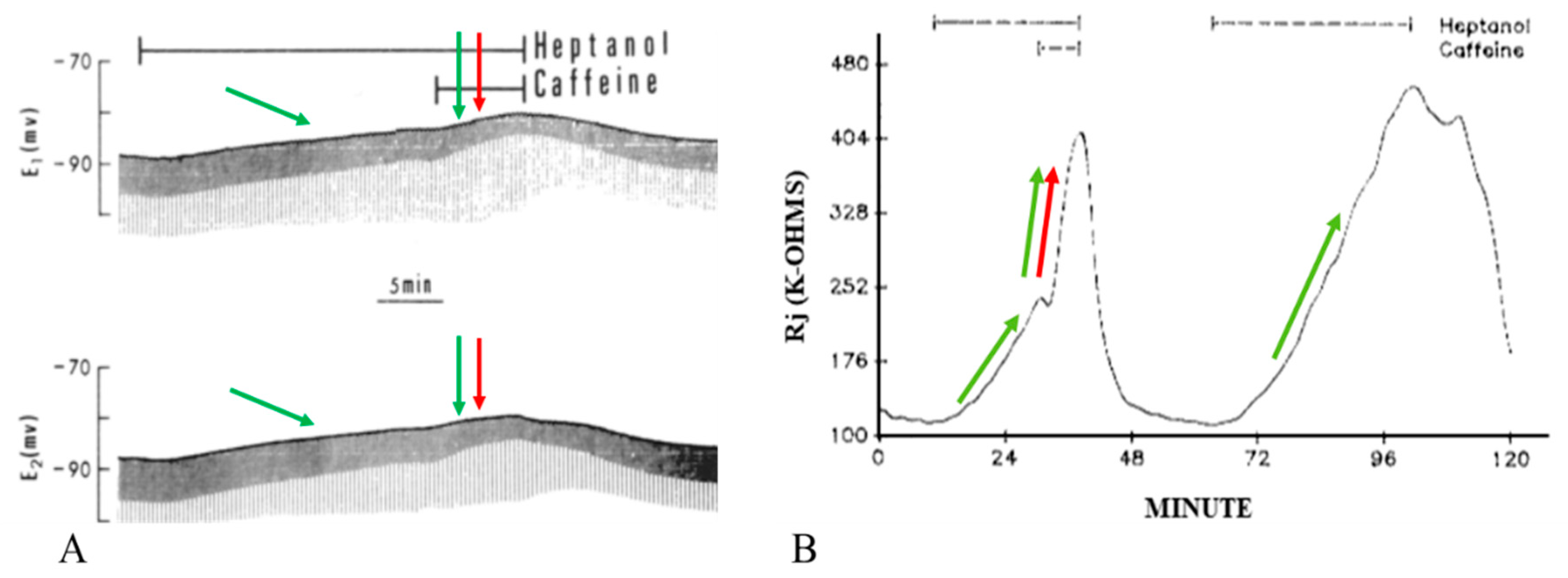
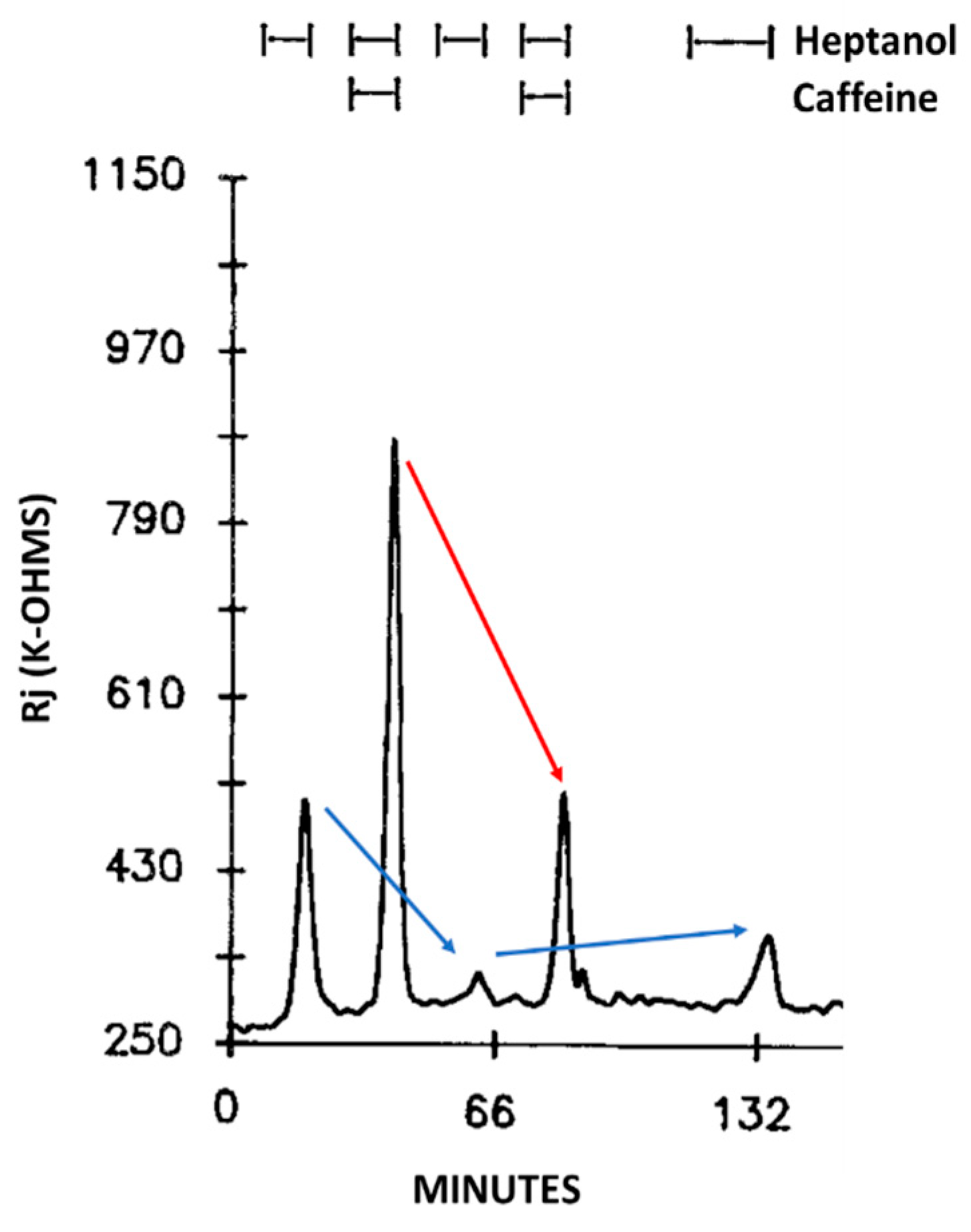
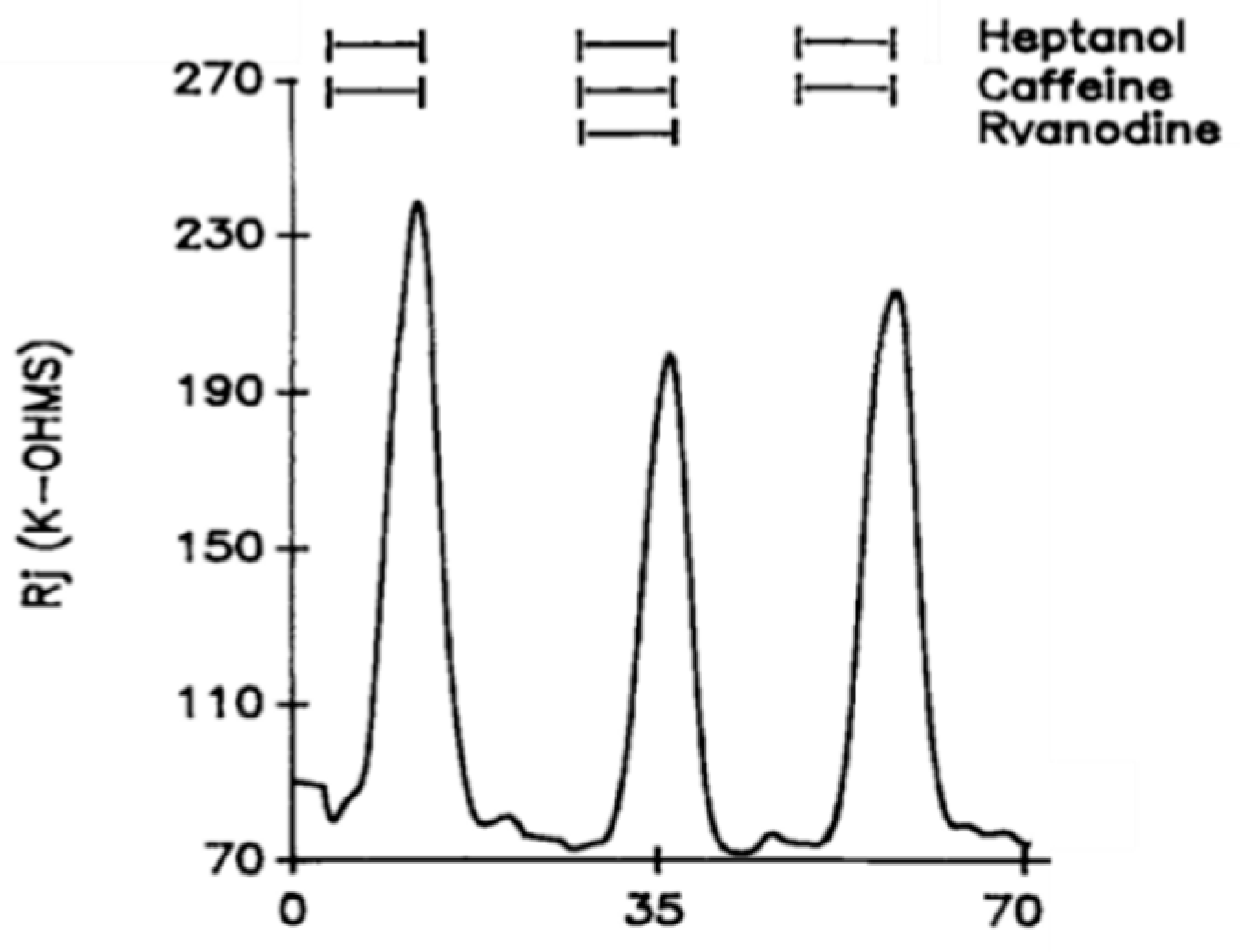

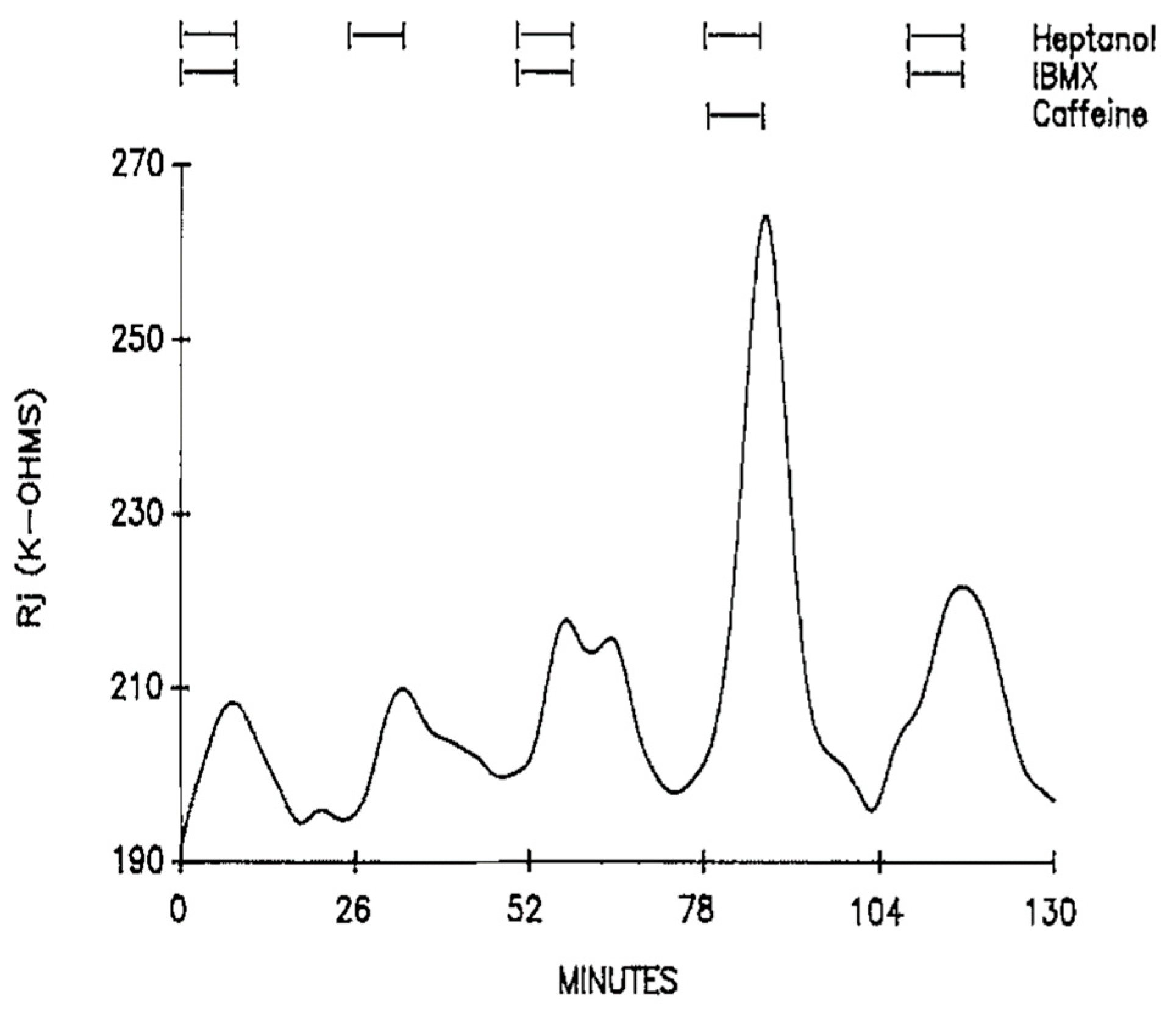

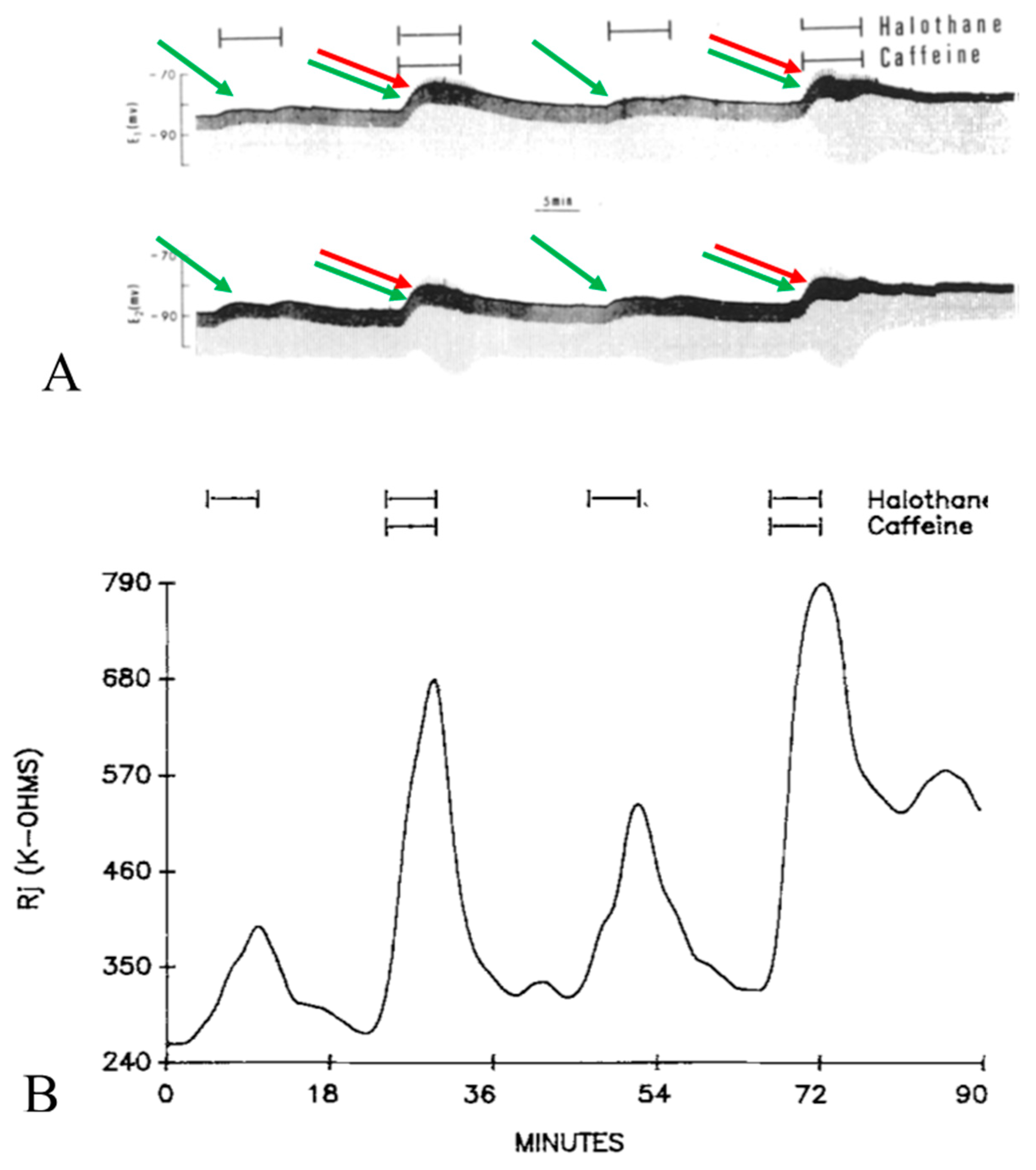
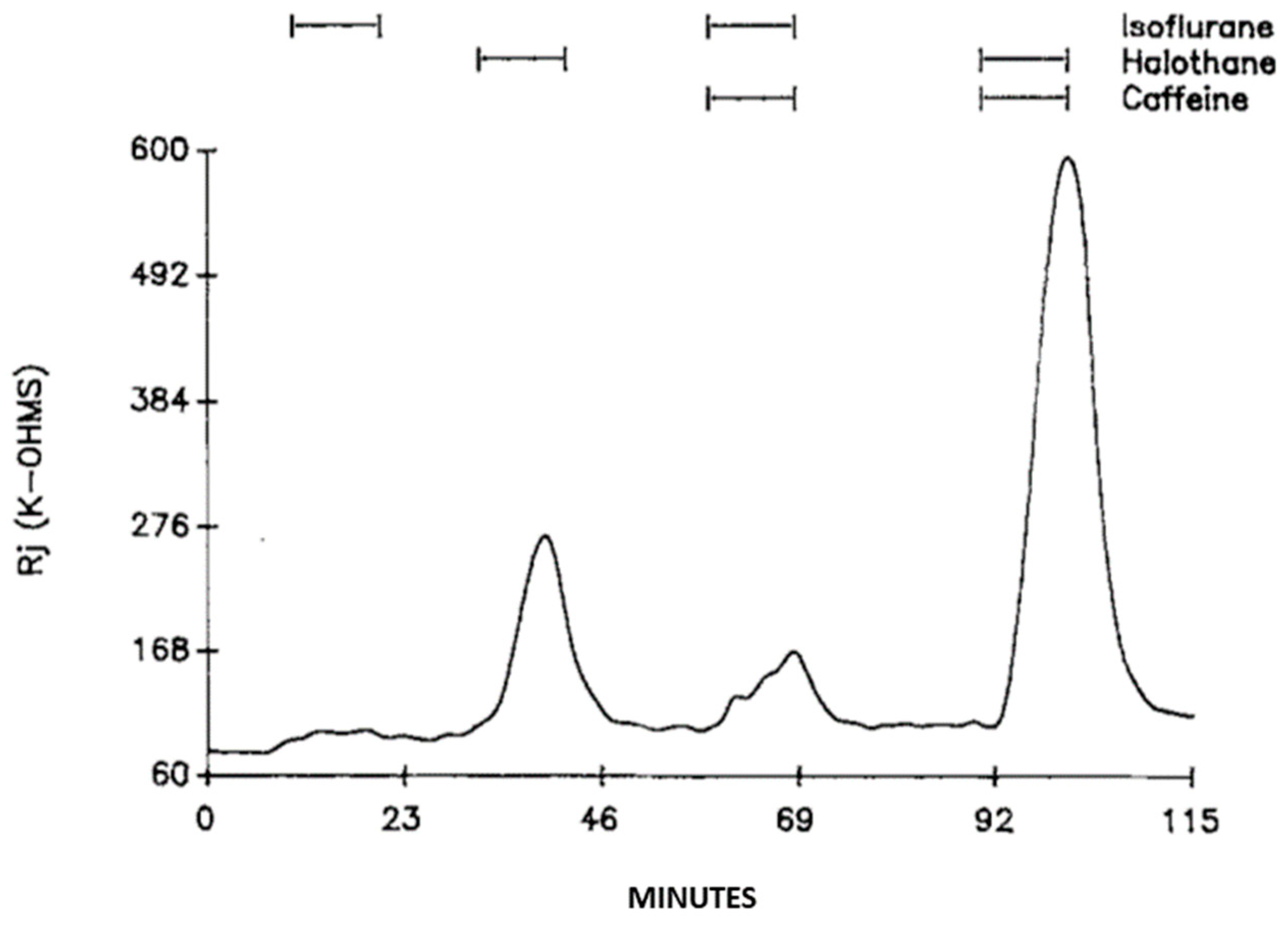
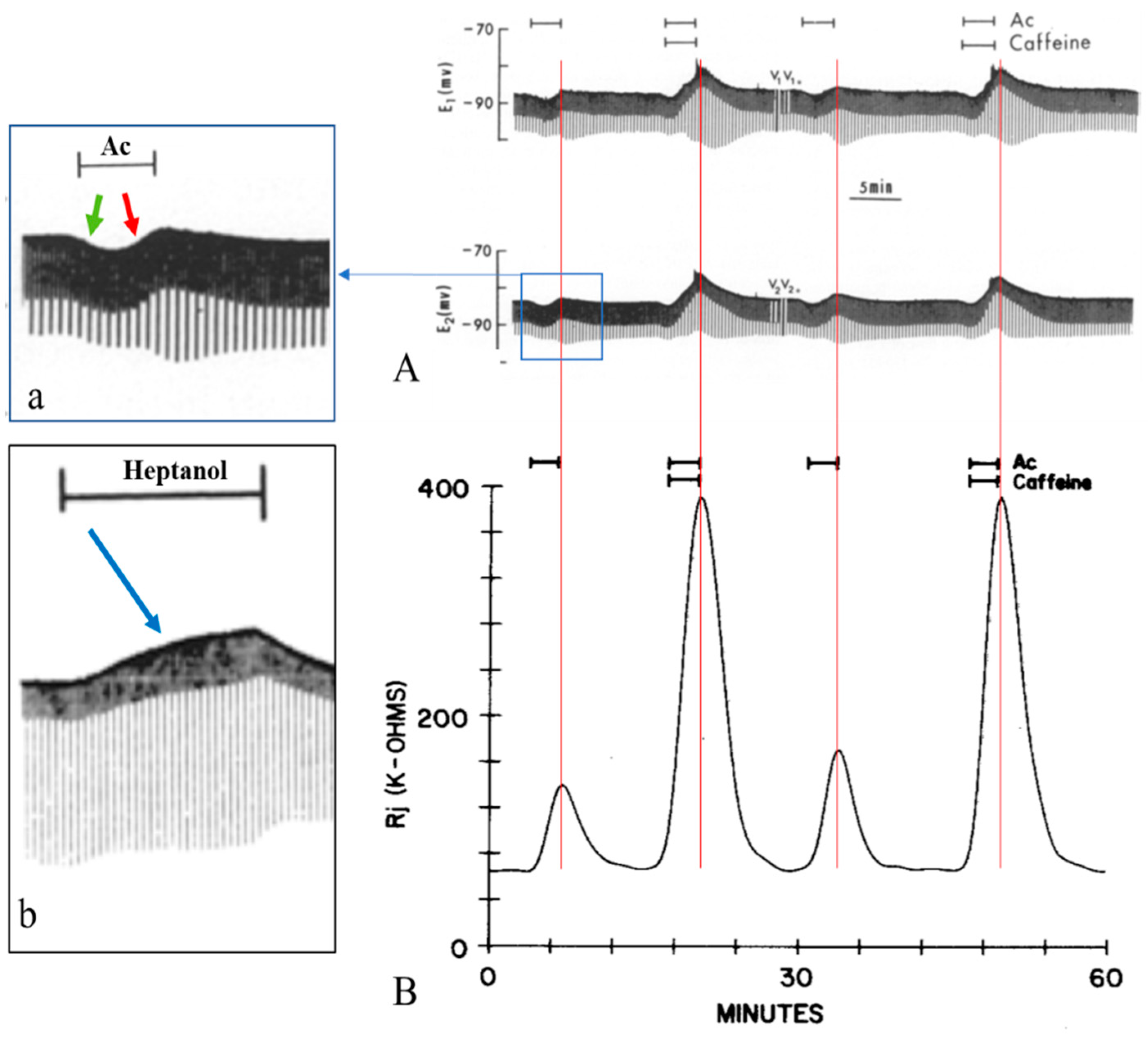
Publisher’s Note: MDPI stays neutral with regard to jurisdictional claims in published maps and institutional affiliations. |
© 2022 by the author. Licensee MDPI, Basel, Switzerland. This article is an open access article distributed under the terms and conditions of the Creative Commons Attribution (CC BY) license (https://creativecommons.org/licenses/by/4.0/).
Share and Cite
Peracchia, C. Anesthetics and Cell–Cell Communication: Potential Ca2+-Calmodulin Role in Gap Junction Channel Gating by Heptanol, Halothane and Isoflurane. Int. J. Mol. Sci. 2022, 23, 9017. https://doi.org/10.3390/ijms23169017
Peracchia C. Anesthetics and Cell–Cell Communication: Potential Ca2+-Calmodulin Role in Gap Junction Channel Gating by Heptanol, Halothane and Isoflurane. International Journal of Molecular Sciences. 2022; 23(16):9017. https://doi.org/10.3390/ijms23169017
Chicago/Turabian StylePeracchia, Camillo. 2022. "Anesthetics and Cell–Cell Communication: Potential Ca2+-Calmodulin Role in Gap Junction Channel Gating by Heptanol, Halothane and Isoflurane" International Journal of Molecular Sciences 23, no. 16: 9017. https://doi.org/10.3390/ijms23169017





